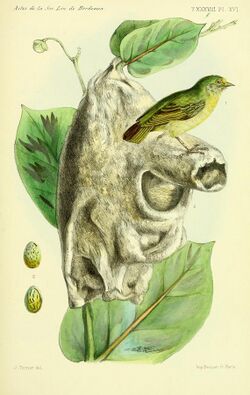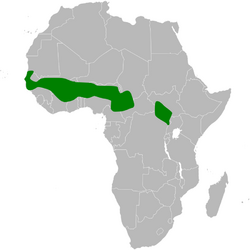Biology:Yellow penduline tit
| Yellow penduline tit | |
|---|---|

| |
| The bird and its nest. Alphonse Trémeau de Rochebrune, 1884 | |
| Scientific classification | |
| Domain: | Eukaryota |
| Kingdom: | Animalia |
| Phylum: | Chordata |
| Class: | Aves |
| Order: | Passeriformes |
| Family: | Remizidae |
| Genus: | Anthoscopus |
| Species: | A. parvulus
|
| Binomial name | |
| Anthoscopus parvulus (Heuglin, 1864)
| |

| |
| Synonyms | |
|
Aegithalus calotropiphilus Rochebrune, 1883[2] | |
The yellow penduline tit (Anthoscopus parvulus) is a species of bird in the family Remizidae. This small yellow passerine bird is found in semi-arid savanna regions of West Africa.
Taxonomy
The yellow penduline tit was formally described in 1864 by the German explorer and ornithologist Theodor von Heuglin under the binomial name Aegithalus parvulus.[3][2] This species is now placed in the genus Anthoscopus that was introduced in 1851 by the German ornithologist Jean Cabanis.[4][5] The genus name combines the Ancient Greek anthos meaning "blossom" or "flower" with skopos meaning "searcher". The specific epithet parvulus is Latin for "very small" (a diminutive of parvus meaning "small").[6] The yellow penduline tit is considered to be monotypic: no subspecies are recognised.[5]
Description
The yellow penduline tit is around 8 cm (3.1 in) in overall length and weighs 6–8 g (0.21–0.28 oz). It is olive-yellow above with bright yellow underparts and a dull greyish stripe through the eye. The upper wing is brown with feathers edged with yellow. The primaries are edged with buff-white which generates a narrow whitish wing panel. The tail is brown. The bird has a conical pointed bill and strong legs. The sexes are alike.[7]
References
- ↑ BirdLife International (2017). "Anthoscopus parvulus". IUCN Red List of Threatened Species 2017: e.T22711646A118702304. doi:10.2305/IUCN.UK.2017-3.RLTS.T22711646A118702304.en. https://www.iucnredlist.org/species/22711646/118702304. Retrieved 13 November 2021.
- ↑ 2.0 2.1 2.2 Paynter, Raymond A. Jr, ed (1986). Check-List of Birds of the World. 12. Cambridge, Massachusetts: Museum of Comparative Zoology. p. 65. https://www.biodiversitylibrary.org/page/14482182.
- ↑ von Heuglin, Theodor (1864). "Ornithologische Miscellen aus Central-Africa" (in German). Journal für Ornithologie 12 (70): 241–276 [260]. https://www.biodiversitylibrary.org/page/32715252.
- ↑ Cabanis, Jean (1850–1851) (in German, Latin). Museum Heineanum : Verzeichniss der ornithologischen Sammlung des Oberamtmann Ferdinand Heine, auf Gut St. Burchard vor Halberstadt. 1. Halberstadt: R. Frantz. p. 89. https://www.biodiversitylibrary.org/page/49584468.
- ↑ 5.0 5.1 Gill, Frank; Donsker, David; Rasmussen, Pamela, eds (January 2022). "Waxwings and allies, tits, penduline tits". IOC World Bird List Version 12.1. International Ornithologists' Union. https://www.worldbirdnames.org/bow/waxwings/.
- ↑ Jobling, James A. (2010). The Helm Dictionary of Scientific Bird Names. London: Christopher Helm. pp. 49, 293. ISBN 978-1-4081-2501-4.
- ↑ Madge, S.C. (2008). "Yellow penduline-tit". in del Hoyo, J.; Elliott, A.; Christie, D.A.. Handbook of the Birds of the World. 13: Penduline-tits to Shrikes. Barcelona, Spain: Lynx Edicions. pp. 71–72. ISBN 978-84-96553-45-3. https://archive.org/details/handbookofbirdso0013unse/page/71/mode/1up.
Wikidata ☰ Q3319625 entry
 |


